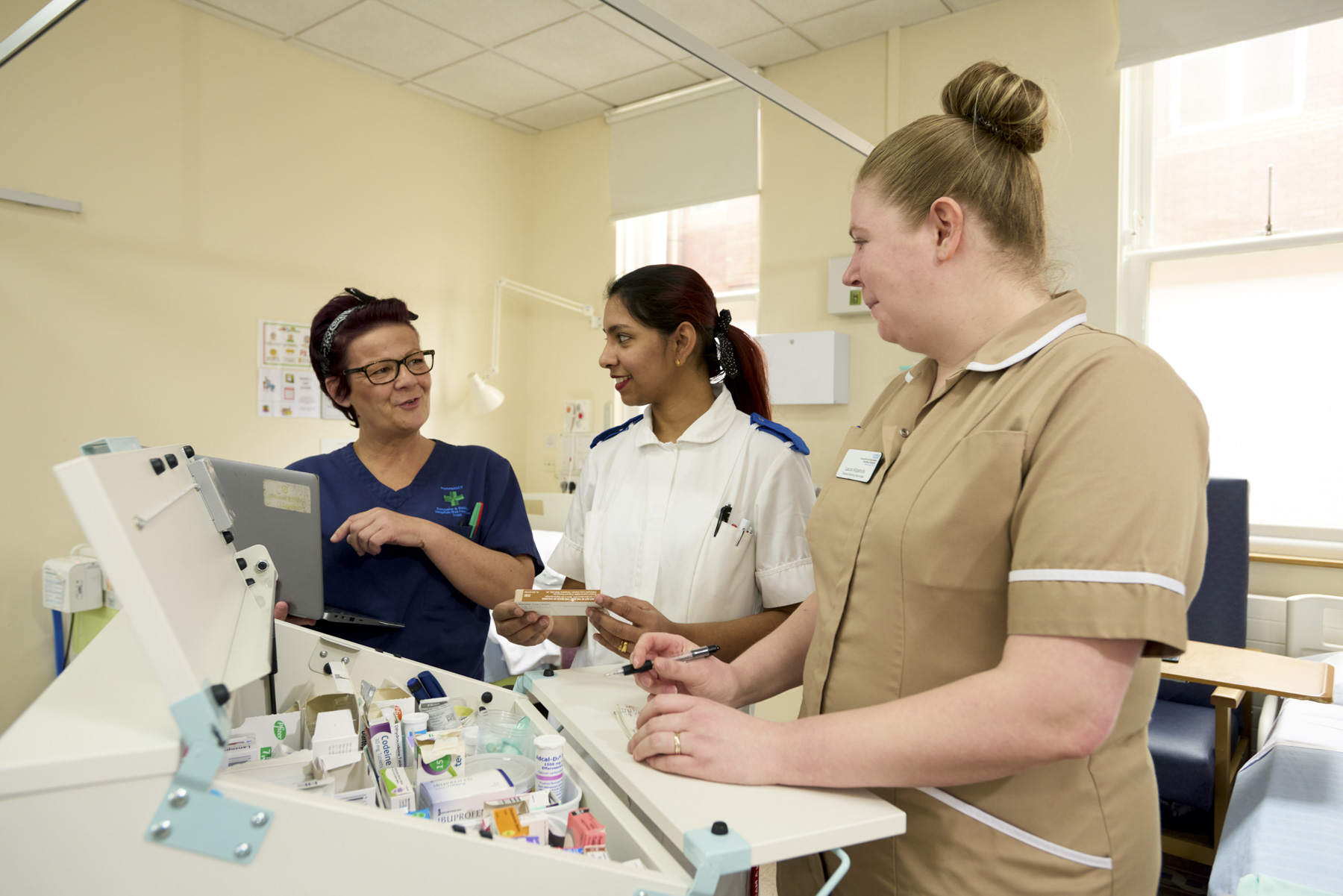There are a number of sections within this part of the document. Using the links below, or to the side, you can skip to specific sections.
- Workforce and planning
- Look after our people
- Improve belonging in the NHS
- Work differently
- Grow for the future
- Approach to workforce planning
- Workforce challenges
- Developing our workforce
- Health and Wellbeing
Jargon busting:
Despite our best efforts there may be a number of acronyms as well as NHS jargon in the our Operational Plan for 2024/25. To help, we have created this handy glossary of terms.
If you need this page in another language, please head to: https://translate.google.co.uk. For more accessibility options and information, please visit: https://www.dbth.nhs.uk/a-z/accessibility/
Workforce and planning
Improve retention and staff attendance through a systematic focus on all elements of the NHS People Promise
Implement actions for 2024/25 from the Long Term Workforce Plan, including the agreed increase in education places in 2024/25 for Nursing Associates, Advanced Clinical Practitioners and Physician Associates
System workforce numbers must be aligned to the financial resources available. Substantive staffing growth should come with commensurate and demonstrable reductions in temporary staffing use
Our people strive daily to provide excellent care both effectively and efficiently. We have collaborated with our workforce to design and develop the DBTH Way to ensure the presence of a compassionate and inclusive culture where leaders at all levels inspire, empower and enable colleagues to stay and thrive.
Our ambitions to improve colleague experience and retention, increase productivity, develop a culture of flexible/agile working, to implement regional multi professional education and training investment plans are all underpinned in our People Strategy 2023 – 2027.
A Learning Needs Analysis has been incorporated into the business planning process to ensure we align our educational needs with our workforce needs. We have also introduced the Training Framework to clearly identify the levels of education required to provide safe and efficient care.
The Kark recommendations will be implemented as well as the NHS leadership competency framework for board members.

Look after our people:
- Improve retention by delivering the NHS People Promise to improve the experience of our workforce. This is being achieved through continuing our progress on culture change regards flexible and agile working, the development of a nursing/HCA workforce retention faculty, and early/mid/late career conversations.
- Continue to support the health and wellbeing of our workforce, which is supported by refreshing our health and wellbeing diagnostic framework, review of financial wellbeing support and access to support services and investment in our Occupational Health service, improving the teams capacity to support health and wellbeing, reduce absence levels and to reduce time to hire.
- Improve attendance by addressing the root causes of sickness absence and, where appropriate, supporting staff to return to work.
- Continue to develop a just culture and supportive framework linking People & Organisational Development, Central Nursing (PSIRF) and Speaking Up, developing policies, processes and guidance for managers and employees.
- The DBTH Way is being embedded into working lives at DBTH and weaved into practices such as recruitment, appraisals and leadership development as well as adapting the expectations of line managers in relation to people management.

Improve belonging in the NHS:
- Improve the Black, Asian and minority ethnic disparity ratio, including delivering the six high impact actions to overhaul recruitment and promotion practices such as through the Board Diversity Development Programme and Reciprocal Mentoring Programme.
- Review and continue to deliver on the Trust Equality Inclusion and Diversity improvement plan, which incorporates the NHSE high impact actions
- Support the continued development and growth of the Trust Race Equality, LGBT and all Staff Networks.

Work differently:
- Review through workforce planning the continued introduction of new roles, such as anaesthetic associates and first contact practitioners, and expanding advanced clinical practitioners.
- Develop the workforce required to deliver multidisciplinary care closer to home, including supporting the growth of virtual wards and discharge to assess models.
- Ensure the highest level of attainment set out by the ‘meaningful use standards’ for e-job planning and e-rostering is met to optimise the capacity of the current workforce.
- Establish, or become part of, volunteer services such as the NHS cadets and NHS reservists.
- Introduction of trust wide succession planning which will dovetail into our annual appraisal season.

Grow for the future:
- Leverage the role of NHS organisations as anchor institutions/networks to widen participation and create training and employment opportunities, including through expanding apprenticeships as a route into working in health and care.
- Make the most effective use of temporary staffing, including by expanding collaborative system banks and reducing reliance on high-cost agency staff.
- Ensure training of postgraduate doctors continues, with adequate time in the job plans of supervisors to maintain education and training pipelines.
- Ensure sufficient clinical placement capacity to enable students to qualify and register as close to their initial expected date as possible.
- Implement our newly developed talent management tool, Scope for Growth to support growing our own talent.
- The launch of our own annual Leadership conference which will further enhance the quality of our leadership talent and pipeline.

Approach to workforce planning
To support workforce planning in the Trust, the organisation is in the final phase of introducing a strategic workforce planning tool which will support the development of workforce plans and improve the workforce planning capacity and capability with the Trust.
As we transition to introducing and embedding the tool we will collaborate with key workforce leads in the Trust for nursing, midwifery, medical staff, healthcare scientists, administrative and clerical and Allied Health Professionals.
Colleagues within finance, people and OD and recovery, innovation and transformation teams are collaborating with divisions and directorates to create good quality workforce plans that will meet financial control totals. A plethora of information and data has been collected and collated, enabling rich and meaningful discussions to emerge to develop and shape future workforce requirements, developments and plans.
Support has also been provided from Educational & Research colleagues with regards to identifying training posts and numbers to further discussion and liaison with educational providers.
Scheduled support meetings to review draft plans and to ensure data triangulates are ongoing to review activity plans against financial and manpower plans.

Workforce challenges
The combination of national skills shortages, hard to recruit to posts and sickness absence has resulted in the Trust being reliant on high agency and bank usage. The Trust is committed to reducing agency and bank usage.
Retention of our workforce and retaining the skills in our services, is vital given the workforce challenges that exist. Efforts continue around enhancing our retention toolkit, promoting an internal transfer register, succession planning, talent management, learning from leavers, leadership development and growing our own through apprenticeships.

Developing our workforce
The Trust is involved in a number of initiatives at a regional level to support workforce development across the system and within the organisation, the Trust is a member of the ICS Retention Working Group and a member of the Stay and Thrive Group both of which focus on supporting retention strategies within the Trust.
We continue to invest in apprenticeships and successfully spend the levy.

Health and Wellbeing
Looking after ourselves and each other
As outlined in the Trust People Strategy 2023 – 2027, the Trust continues to further develop its Health & Wellbeing (HWB) provision for its employees. We are committed to providing a wide-ranging, sustainable, accessible and proactive health and wellbeing offer to support our colleagues at the times they need it, as well as preventative measures to support continued good health and taking into account population health needs.
In 2023, the Trust evaluated its HWB diagnostic tool against each section of the NHS health and wellbeing framework, aligned with the NHS model describing what ‘good’ looks like. This allows the Trust to identify and prioritise our health and wellbeing efforts. The HWB Framework supports benchmarking and evaluation of our health and wellbeing activities and provides assurance through its governance routes via HWB Committee and the People Committee.
The Trust has a HWB team consisting of three employees. They coordinate and deliver the HWB provision though a range of methods; direct facilitation of activities, coordinating the delivery through other parties (internal DBTH services and external providers) and accessing HWB provision offered through partner NHS organisations and Integrated Care Boards.
Embedding new ways of working
The Trust continues to further develop technology capability across a range of functions by supporting the continued roll out of IT HR Information systems to improve systems and improve efficiencies across the organisation.
Progress continues to be made with existing implementation plans and schedules relating to e-job planning, e-rostering, HR Casework Database and the Occupational Health COHORT Information System. All of which are designed to introduce efficiencies in ways of working to realise a range of benefits, both in relation to staff engagement and wellbeing and financial terms.
The Trust is progressing plans to introduce a new workforce information tool to help support and drive improved workforce planning function and capacity. Key to the work is the engagement of colleagues across the organisation, providing training and support to managers on the use of the tool and improving workforce planning capability across the Trust.
We have undertaken a procurement exercise to review our medical people information systems which has resulted in the provision of medical people systems through different suppliers for e-rostering and e-job planning, presenting a range of opportunities to improve and develop medical people systems information and data to help inform future service provision.
Assumptions
It is reasonable to assume that there will be more industrial action in 2024/25, that our workforce and therefore services will not grow due to financial pressures and we will continue to consider practical and innovative ways to effectively manage and reduce the temporary workforce spend.
Addressing workforce inequalities
The Trust will continue to work to develop the culture of the organisation, striving towards ensuring the Trust is an employer of choice and working with key partners to establish the Trust as an anchor institution. Key actions to support our ambitions:
- Continued development of the Trust leadership offer aligned with the DBTH Way to support and drive culture change, supporting compassionate leadership and diversity in leadership development
- Continue to undertake work around the gender pay gap reporting to inform and develop policy
- Continue to progress actions in relation to inclusive recruitment practices, in line with the action plan and working with system partners where relevant continue to develop and support the reciprocal mentorship programme already successfully implemented in the Trust (currently on cohort 3) and the Board Development Delegate Programme
- Introduce and embed the Trust’s new approach to succession planning and talent management (Scope for Growth), ensuring positive action around equity of opportunity
Vaccination planning
Delivery of the vaccine programme is expected to remain a key priority as we look ahead to 2024/25. The main focus of the programme is directed at influenza vaccinations and ensuring there is the infrastructure to respond as needed with planning underway for a booster programme for delivery in the Autumn
In 2023 we saw a decline in the numbers of NHS employees across the system taking up vaccinations for influenza and COVID. In 2024, the Trust will be delivering a multifaceted approach;
- Working with divisions in expanding our peer vaccinator numbers across all DBH sites
- Offering vaccination clinics led by occupational health services
- Effective workforce engagement and communications raising awareness of the need and importance of vaccination so that employees can make informed decisions on consenting for vaccination.
- Working with partnering health providers such as General Practices and pharmacies to ensure that vaccination status reports are accurate and up to date on the vaccination software.
Triangulation process for workforce
Colleagues within finance, people and OD and recovery, innovation and transformation teams are collaborating with divisions and directorates to create good quality workforce plans that will meet financial control totals. A plethora of information and data has been collected and collated, enabling rich and meaningful discussions to emerge to develop and shape future workforce requirements, developments and plans.
Support has also been provided from Educational & Research colleagues with regards to identifying training posts and numbers to further discussion and liaison with educational providers.
Scheduled support meetings to review draft plans and to ensure data triangulates are ongoing to review activity plans against financial and manpower plans.

- Next section: Quality
Content out of date? Information wrong or not clear enough? Report this page.

